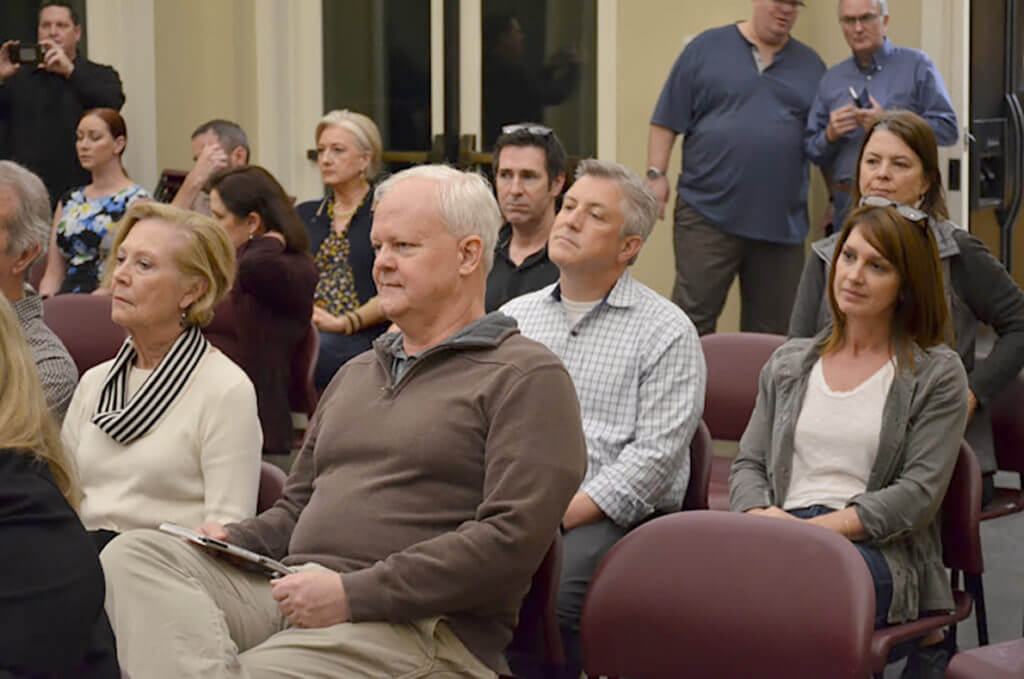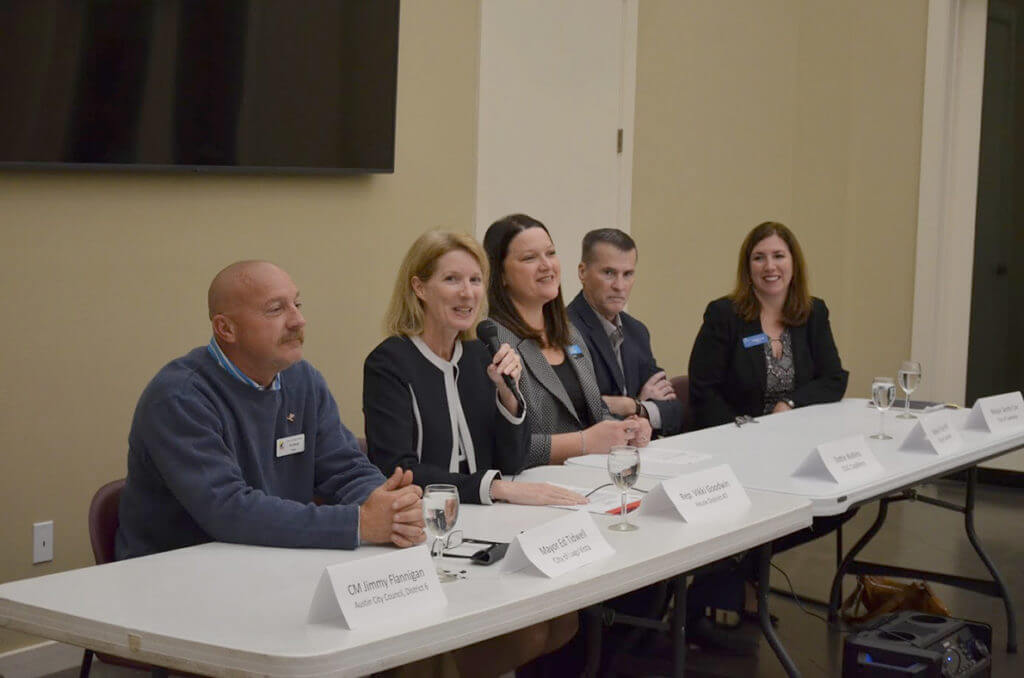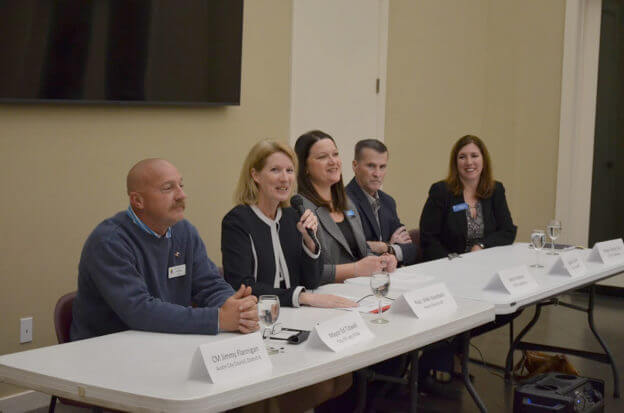
By LYNETTE HAALAND, Four Points News
A transit town hall meeting in Steiner Ranch on Tuesday brought together several area leaders including mayors from Lakeway, Leander and Lago Vista, Austin City Council Member Jimmy Flannigan, District 6, and Dottie Watkins, chief operating officer and chief customer officer of the Capital Metropolitan Transportation Authority. State Rep. Vikki Goodwin, D-Austin of District 47, hosted and moderated the panel discussion which was dominated by Watkins of Capital Metro.
Discussion included experiences with Capital Metro in the outlying areas, as well as funding, new tools and projected goals of the agency.
According to the three mayors, the transit offerings have some limitations for them and their communities. Steiner community members pointed out that they feel like the Four Points area is not being served by Capital Metro but that residents are helping pay for it elsewhere.
Between 25 and 30 people attended the town hall, most were from Steiner but the discussion largely did not include the Four Points area. During the question period, some of the focus was localized.
“Northwest Travis County, including Steiner Ranch and River Place, does contribute a 1 cent sales tax (to Capital Metro),” said David Greear, former resident of Steiner and now resident of Comanche Trail. He is also the engineer division manager at Travis County Transportation and Natural Resources.
Greear estimates that some $6 million a year goes into Capital Metro from northwest Austin. He thinks the Four Points area should be able to benefit from service out here based on what it has been contributing over the past three years.
“I think that with so many residents in Steiner Ranch and the area, I would think there would be a strong concentration of people wanting to go from Steiner or Four Points to downtown,” Greear said.
Capital Metro’s Watkins said one of the big issues is the need for a Park & Ride collection point. “We need to find a place to land,” she said.
She cited that there was a Capital Metro stop several years ago at 3M, when it operated in Four Points, but only about five people rode it and it was discontinued. But it was pointed out by an audience member that the stop was different than traditional transit, it came from downtown to Four Points, and was a reverse commute.
Similar to areas like Four Points, Mayor Ed Tidwell said Lago Vista, which has a population of some 7,000 residents, pays into Capital Metro and is not getting service there. He would like that to change.
“We would love to get into Cedar Park. If we can get there, that would be fantastic. If we cannot, then we’d like to change to be a contract like Round Rock,” Tidwell said.
Steiner resident Stan Murff commented that the Steiner Ranch area is more than 10,000 residents. “We’re not a city,” Murff said, referencing that we are not getting the attention of other municipalities.
It takes Murff and his wife an hour during peak traffic times to go to babysit their granddaughter at Shoal Creek. “There’s nothing here (tonight) that says, help is on its way,” he said.
Goodwin asked if there would be a Park & Ride in the Four Points area in the future.
“We’re trying to figure that out. We’re talking to TxDOT about right of way for a Park & Ride,” said Watkins, who added some Park & Ride’s need up to 200 parking spaces.
But Flannigan said after the town hall, that land will not be an issue for a collection point. He is confident it will not be difficult and cited that land near the bypass road going in between RM 2222 and RM 620 could be a potential transit collection point. He expects to know more in about six months.
Capital Metro recently launched its Pickup app which is an on-demand shuttle service like Uber or Lyft. The agency operates six zones currently (East Austin, Leander, Walnut Creek, Northeast, Manor, and Exposition) within roughly a 5-square-mile area to help ensure that it can reach people in about 15 minutes. The fare is $1.25 a ride.
“It’s a service used to connect the area where it doesn’t make sense to have a full bus,” Watkins said.
Pickup was launched in Leander and Mayor Troy Hill said it is helping to solve the challenge of getting residents to and from Capital Metro’s commuter trains that run parallel to US 183.
“I think it’s great for us,” Hill said. But he stressed the importance for a more comprehensive, regional approach to transit and building a cohesive transportation system. He’s looking both now and in the future since Leander, with its population of almost 50,000 residents, is only 50 percent built out.
“When you’re a small city and growing like Leander is, we need roads and money to build roads,” Hill said. “Personally I think mass transit is a state issue.”
Similarly Lakeway is about 50 percent built out at this point. Mayor Sandy Cox expects Lakeway to be fully built out in 15 to 20 years and to double its population from some 15,000 now to approximately 29,000 residents.
Lakeway recently completed research that not only estimates the population growth but also shows that some 90 percent of employees who come to work in Lakeway are from outside of Lakeway, and most have to use RM 620 to get in which adds to congestion.
As she has an eye toward the future, Cox wants to see how Capital Metro can help Lakeway now.
Another town hall audience member commented that if Capital Metro’s new Pickup ride app was in Four Points, there would be more than a handful of riders. “It’s a great concept but it’s of no help in Steiner,” they said.
Watkins said that Capital Metro’s proposed plans include some regional transit improvements.
“Not every single place in the region is going to be a logical place to [put] a bus route or light rail down the street, but we know a core of our region calls for that and other areas call for connection,” Watkins said.
She added that the agency is looking to spend $1.5 billion in additional bus service and Park & Ride locations throughout Austin.
“We are working on a system that works with a network. We are starting to try to refine it,” Watkins said. “It might include underground rail. Our most constrained areas are our most dense so we may be tunneling through the downtown area. The expense buys you ability and capacity.”



